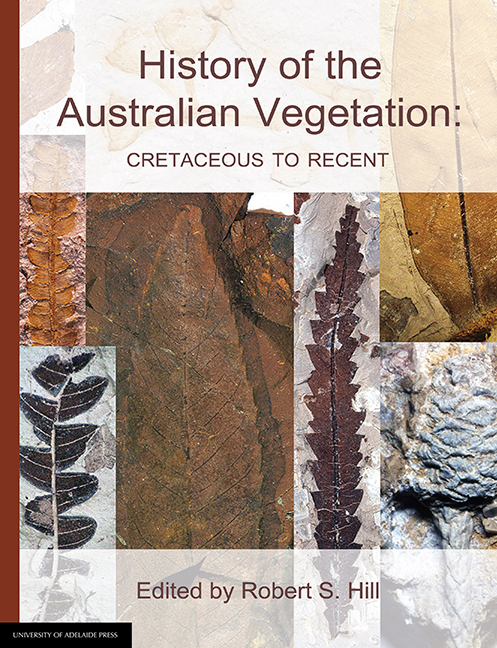Book contents
- Frontmatter
- Contents
- List of contributors
- Introduction to the 2017 edition
- 1 The Australian fossil plant record: an introduction
- 2 Maps of late Mesozoic-Cenozoic Gondwana break-up: some palaeogeographical implications
- 3 The background: 144 million years of Australian palaeoclimate and palaeogeography
- 4 Palaeobotanical evidence for Tertiary climates
- 5 Landscapes of Australia: their nature and evolution
- 6 Patterns in the history of Australia's mammals and inferences about palaeohabitats
- 7 Australian Tertiary phytogeography: evidence from palynology
- 8 Cretaceous vegetation: the microfossil record
- 9 Cretaceous vegetation: the macrofossil record
- 10 Early Tertiary vegetation: evidence from spores and pollen
- 11 The early Tertiary macrofloras of continental Australia
- 12 Cenozoic vegetation in Tasmania: macrofossil evidence
- 13 The Neogene: a period of transition
- 14 The Oligo-Miocene coal floras of southeastern Australia
- 15 Quaternary vegetation
- 16 The history of selected Australian taxa
- Taxonomic index
- General index
10 - Early Tertiary vegetation: evidence from spores and pollen
Published online by Cambridge University Press: 25 July 2017
- Frontmatter
- Contents
- List of contributors
- Introduction to the 2017 edition
- 1 The Australian fossil plant record: an introduction
- 2 Maps of late Mesozoic-Cenozoic Gondwana break-up: some palaeogeographical implications
- 3 The background: 144 million years of Australian palaeoclimate and palaeogeography
- 4 Palaeobotanical evidence for Tertiary climates
- 5 Landscapes of Australia: their nature and evolution
- 6 Patterns in the history of Australia's mammals and inferences about palaeohabitats
- 7 Australian Tertiary phytogeography: evidence from palynology
- 8 Cretaceous vegetation: the microfossil record
- 9 Cretaceous vegetation: the macrofossil record
- 10 Early Tertiary vegetation: evidence from spores and pollen
- 11 The early Tertiary macrofloras of continental Australia
- 12 Cenozoic vegetation in Tasmania: macrofossil evidence
- 13 The Neogene: a period of transition
- 14 The Oligo-Miocene coal floras of southeastern Australia
- 15 Quaternary vegetation
- 16 The history of selected Australian taxa
- Taxonomic index
- General index
Summary
This chapter reviews palynological evidence for the nature of the early Tertiary flora and vegetation of Australia. Because of difficulties in distinguishing between Late Oligocene and Early Miocene palynofloras, the interval of time covered is Paleocene to late Early Miocene, 65 to ca 18.5 million years (Ma) based on the geochronological time scale of Harland et al (1990).
The period is critical in tracing the origins and rise of the modern Australasian vegetation from an early, diverse angiosperm flora, such as that sampled in rift valley sequences along the southern margin of Australia during the Maastrichtian. Whether this flora was representative of inland regions or the northwest margins is debatable (see Twidale & Harris, 1977; Harris & Twidale, 1991), but it is clear that during the Danian a floristically more simple vegetation dominated by conifers and ferns prevailed in coastal/ lowland southern Australia. In most general terms, the subsequent history of the early Tertiary vegetation is the rise to prominence of floristically complex nonseasonal mesothermal-megathermal forest types and their timetransgressive replacement by more open or seasonal mesothermal -microthermal types during the Miocene. The same period saw the final separation of Australia from Antarctica, its northward drift through some 20 degrees of latitude and an irregular but overall decline in global high latitude sea surface temperatures of ca 13 °C from an Early Eocene maximum.
The last major reviews incorporating evidence for the early Tertiary vegetation (Barlow, 1981; Lange, 1982) concentrated upon individual elements within the flora, utilising cytogenetic, cladistic and other phylogenetic studies to augment but also to overcome deficiencies in the fossil database. Since these reviews, the substantial increase in the volume of published and unpublished information allows plant fossils to be used as primary evidence for the history of the early Tertiary flora and vegetation. Not surprisingly, this vegetation is found to have been as heterogeneous in space and labile in time as that of the Quaternary. Accordingly, this chapter concentrates on the fossil record per se, focussing on the sites and on the spore and pollen sequences that are available and what these imply, rather than adopting the broader approach of earlier reviews.
- Type
- Chapter
- Information
- History of the Australian VegetationCretaceous to Recent, pp. 189 - 261Publisher: The University of Adelaide PressPrint publication year: 2017



